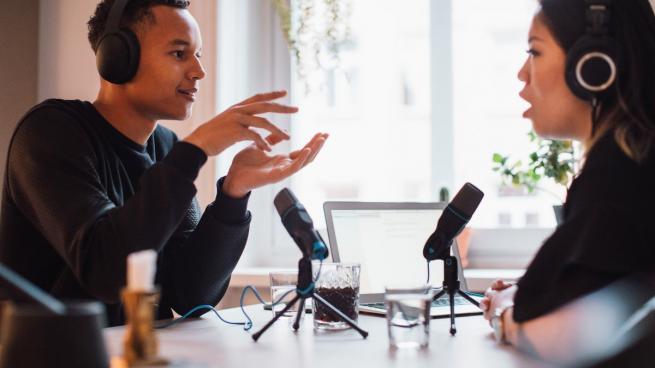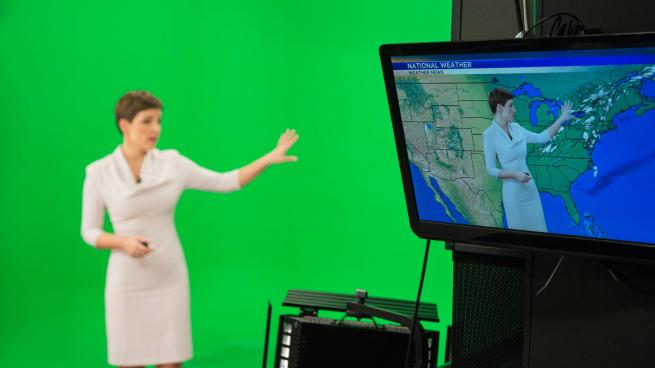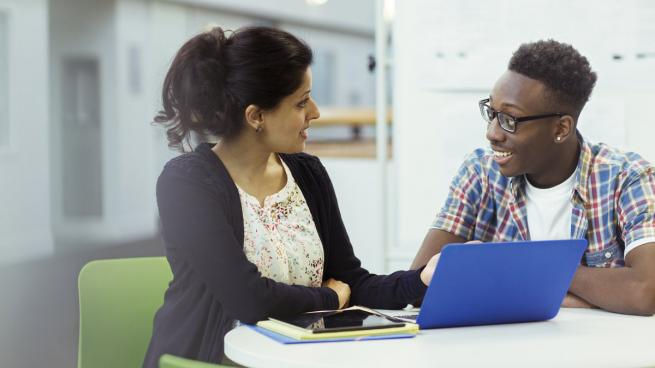A digital detox podcast

Listen to the podcast about doing a digital detox to practise and improve your listening skills.
Do the preparation task first. Then listen to the audio and do the exercises.
Preparation
See More
Transcript
See More
Presenter: So, we’re back in the studio. Welcome back, everyone. My name’s Rick Walker. From our laptops to our televisions, from the displays on our smartphones to those on our satnavs, we are in front of screens all the time. Have you ever wondered what it would be like to disconnect completely? To choose not to have access to the internet? If you have, you may be in need of a digital detox – a total switch-off from all things digital. The idea of people taking a digital detox is becoming more and more popular, especially amongst young people – and today we’re joined by someone who’s tried a number of digital detox activities and is here to give us some advice about it. Amanda Vince, welcome to the studio.
Amanda: Thank you very much.
Presenter: So, Amanda, you work for a fashion magazine in London, right? I guess your work means you need to be online a lot.
Amanda: Oh, yes. Apart from the hundreds of emails I get every day, I’m always browsing fashion websites, as well as online videos. I also need to be very active online, especially on Twitter and Instagram – sharing what we’re doing in the magazine, interacting with designers, photographers, influencers … it never stops, literally. Then of course there’s my friends and family to keep in touch with online too, and for me, my work grew out of my passion, so friends and work colleagues aren’t two totally separate groups of people and it all gets a bit messy online sometimes. I think I’m online for at least 12 hours a day.
Presenter: So, how did you get the idea for a digital detox?
Amanda: I read a book about it, called Log Off: How to Stay Connected after Disconnecting. The author’s name is Blake Snow. That book gave me some really good advice and made me think about trying to change some of my digital habits. I started with removing distraction.
Presenter: What do you mean by that?
Amanda: That means turning off alerts, buzzes, alarms or notifications of any kind. I had notifications set up for everything, and it meant I was always being forced to look at my phone. Removing all of them except for important contacts helped me focus immediately. The book also made a really good point, that we should ask ourselves ‘Why?’ every time we take out our phone. I realised that most of the times I looked at my phone were because I was trying to avoid or ignore something else happening right in front of me. It was an automatic habit.
Presenter: I have to confess, that happens to me too. But what else are you going to do when you’re standing in line at the bank or waiting for your train?
Amanda: OK, yes, I’m the first to admit that it’s great for helping time go by. But speaking personally, I found I wasn’t just checking my phone to kill time when I was alone. I was also doing it with friends or family around.
Presenter: Hmmm … right. Well, so far, this doesn’t sound too drastic. Turning off notifications and becoming aware of when we use our devices. That sounds easy.
Amanda: Yes, it’s the first step. Once we begin to realise just how much of a grip our devices have on us, then we’re ready to really take the next step. First, my partner and I did a weekend with absolutely no screens. She found it easier than I did. For me, it was a little bit scary at first but it turned out to be a pretty rewarding experience.
Presenter: A whole weekend, huh? I don’t know if I could …
Amanda: I think everyone has to do this at their own pace. If a weekend feels too much, maybe just try for an evening. Then work your way up to more. I guarantee, once you’ve tried it, you’ll want to try it again. We’re going to try for a whole week in the summer.
Presenter: OK, let’s pause there then and see what our listeners have to say. You can call us here directly, or send us a message on any of our social media channels … oops, should I be saying that? Anyway, more after the break.
Task 1
See More
Task 2
See More
An interview about listening skills

Listen to the English teacher talk about listening to practise and improve your listening skills.
Do the preparation task first. Then listen to the audio and do the exercises.
Preparation
See More
Transcripts
See MorePresenter: So, today’s expert teacher is Gabriella, a university English teacher from Leeds. Gabriella, hi and thanks for joining us today.
Gabriella: Thanks for having me!
Presenter: So, I have to confess today’s topic is something I am really bad at: listening. Most people say speaking is the most stressful part of learning a new language but, for me, with my B1 German, speaking isn’t so bad. At least I’m in control of it. But listening … woah … people speak so fast and it’s like my brain just shuts down. Am I just really strange and bad at listening? Tell me, honestly, I can take it.
Gabriella: No, you’re not strange. In fact, it’s really common. You know, in exams most people do pretty well in speaking compared with listening. Of course, exams are a different situation from real life because in an exam you can’t ask for something to be repeated or explained. You usually have just one or maybe two opportunities to listen to the dialogue and then it’s gone.
Presenter: Right, but in real life I feel stupid always saying, ‘Sorry, can you repeat that, please?’, especially if I still don’t understand even when they repeat it. And people out there listening, I hope you don’t do this – quite often the person just repeats what they said equally as fast and I’m still lost!
Gabriella: They do, don’t they? In real life, you’ve got two strategies. One is to pretend to understand and get out of the conversation as fast as you can.
Presenter: Yep, sounds familiar!
Gabriella: But, obviously that’s not going to help if it’s a conversation with high stakes. It might have important consequences. I mean, if you’re just chatting with a stranger at the bus stop, it doesn’t matter. But imagine you’re at a government office or a bank, trying to find out what paperwork you need to get your ID or open a bank account. What can you do then?
Presenter: I hope you’ve got the answer, Gabriella, because I’m coming out in a cold sweat just thinking about either of those situations!
Gabriella: The other strategy is to summarise what they said.
Presenter: But how can you do that if you didn’t understand what they said?
Gabriella: Ah, well, you only start the summary, so you might say, in German in your case, ‘OK, so the first thing I have to do is …?’ and make it a question. Or, for example, ‘And which office is that again?’ Break it down into smaller questions and the other person will naturally start answering them. That way you’re controlling the conversation a bit more.
Presenter: I get you …
Task 1
See More
Task 2
See More
A weather forecast

Listen to a weather forecast and answer the questions to practise and improve your listening skills.
Do the preparation task first. Then listen to the audio and do the exercises.
Preparation
See More
Transcripts
See MoreHello and good morning! Well, we’re off to a good start in the south this week, as most of the rain from the weekend has disappeared – just a few patches of cloud and maybe some showers here on the east coast. They’ll all clear up by lunchtime, though. Over the next day or so, London and the area around Kent can expect a couple of isolated showers, but mostly dry through until Thursday.
It’s not such good news for the north-west this week, I’m afraid: more wet weather, and not a lot of sunshine. Some of today’s showers will be heavy – and even thundery in Manchester and across the Pennines. Leeds will escape the thunderstorms, with drizzle and light rain only throughout the rest of the day and tonight.
Elsewhere it becomes dry today, but with some foggy patches towards Wales. In England, tomorrow morning will see a dry, bright start in most places, with high temperatures throughout the week. We might see one or two thunderstorms appearing as the week goes on, with temperatures everywhere at 29 to 30 degrees.
By the weekend, unfortunately, the dry weather will make way for mostly cloudy skies and rain. The rain will move from Scotland, down towards the north and reach the south coast by Saturday afternoon. Temperatures, at least, will stay mostly warm at around 21 degrees for the weekend. It might feel like a nice change from the high twenties and early thirties we’ll see in the week. That’s all from me until tomorrow. Enjoy the mini-heatwave while you can!
Task 1
See More
Task 2
See More
A team meeting about diversity

Listen to a team meeting about diversity to practise and improve your listening skills.
Do the preparation task first. Then listen to the audio and do the exercises.
Preparation
See More
Transcripts
See MoreNina: As you know, our team has grown a lot in the past year and we feel we need to address the diversity in the team.
Brenda: How do you mean, ‘address the diversity’?
Nina: Well, we all know that diversity in teams is a good thing, but it can also be a challenge for some people to respect and value people’s differences. We’ve got a really diverse team here – people of different nationalities, backgrounds, religions, ages … and sometimes I don’t feel we make the most of this.
Stefano: Yes, and even if it isn’t specifically challenging, many people are simply unaware of the isolation that some team members may feel because they are different.
Brenda: So, what does this mean? What are we going to do?
Nina: Well, we need to create a workplace charter. You know, one that promotes equality, diversity and inclusion.
Brenda: That sounds like a good idea. But will people just see it as something the management team has created? Maybe they won’t even pay attention to it.
Nina: I know. That’s why we’re going to involve everyone in creating it.
Stefano: That’s a good idea. We could run some workshops and get ideas from the employees about how we can create a more inclusive workplace.
Nina: Exactly. I was thinking that before that we could run some team-building sessions so they can experience the value of diversity for themselves.
Brenda: Yes, I like that. Many people see diversity as something negative, often because there are different opinions or ways of doing things.
Nina: Yes, I know, but if there’s no diversity, then the risk is that we all work in the same way, think the same and see the world the same. This makes it hard to be creative and to innovate.
Stefano: I completely agree, Nina. OK. So, what do you want us to do?
Nina: Stefano, can you look for a successful trainer who specialises in running workshops and team-building sessions on diversity and inclusion?
Stefano: Sure. I’ll be happy to.
Nina: And Brenda, can you find a fun venue? Somewhere that is quite diverse itself. Something that’s not the usual seminar-style environment?
Brenda: Sure. That’ll be fun.
Nina: And I’m going to do some further research into how other organisations are benefiting from their diversity. I can share this with the whole team.
Task 1
See More
Task 2
See More
A design presentation
Listen to the presentation about a new product design to practise and improve your listening skills.

Do the preparation task first. Then listen to the audio and do the exercises.
Preparation
See More
Transcript
See MoreHi, everyone. Thanks for coming to this short presentation on our new product design. As you know, we’ve already redeveloped our ‘Adventure’ shampoo to make it more modern and appealing. And we’ve renamed it ‘Adventure Tech’. Our market research established the target market as men in the 18–40 age range who like to be outdoors and also like technical gadgets, such as smartwatches, drones and things like that. We needed to create a bottle which appeals to that market.
So, today, I’m happy to unveil our new bottle design. As you can see, it’s designed to look like a black metal drinking flask, with some digital features printed on it.
I’d like to talk you through the following three points: the key features, sizing and our timeline for production.
Firstly, you’ll notice it has an ergonomic design. That means it fits smoothly into your hand and can be easily opened and squeezed using one hand. And, it looks like a flask you might use when hiking outdoors. The imitation digital displays are designed to remind the user of other tech devices they may have, such as a smartwatch or smart displays in their home.
I’d now like to tell you about the sizes. It comes in two sizes: the regular size and a small travel size. The travel size is the same type of design – a flask, also with imitation digital displays on the bottle. We were thinking of starting with one and following with the travel-size in a few months, but we’ve worked hard and both are ready now.
Finally, I’m going to talk to you about our timeline for production. You’ve probably heard that we’re launching in two months. In preparation for that, we’re starting the marketing campaign next month. You can see the complete overview of all phases in this Gantt chart.
In summary, the bottle’s been designed for men who like adventure and technology, and it comes in two sizes. The marketing campaign is starting next month and we’re launching the product in two months.
OK. So, any questions? Feel free to also email me for further information in case we run out of time.
Task 1
See More
Task 2
See More
Business news
Listen to the business news to practise and improve your listening skills.

Do the preparation task first. Then listen to the audio and do the exercises.
Preparation
See More
Transcript
See MoreThe first item in the news today is the recent elections that took place across the country. This was a crucial vote, which may see a dramatic change in how the country develops over the coming years. Overall, a 54.5 per cent voter turnout was registered. This represents an increase of 11 per cent over the previous election and six per cent above the average for the past 50 years. There has also been a slight change in demographics, with an increase in youth turnout in the 18- to 24- and 24- to 29-year-old brackets. Despite this increase, young people are still less likely to vote than older people; 84 per cent of voters in the 70 plus age group came to the polling stations.
Moving on, the global digital powerhouse ONK today posted quarterly results which were above forecast. Back in March, Tim Bolling, CEO, issued a profit warning over fears that there would be losses following the recall of their leading product, the 40d device. In fact, the company posted quarterly revenue of US$14.8 billion which represents an increase of 11 per cent from the same quarter a year ago. They also announced that they had sold 21 million 40d devices over the quarter. The company has provided the information that with this level of revenue, there will be a gross margin of 34 to 35 per cent, ultimately leading to a US$1.20 per share cash dividend awarded to shareholders.
And in our final news item we ask, will we soon be saying goodbye to coins and notes forever? The nationwide trend of using cashless payment options is increasing. There are a number of reasons for this development. A key reason for this is a growing interest in reducing the number of items people need to leave their homes with. As almost everyone carries a smartphone with them, and many people also have smartwatches, the ability to pay for things using one of these two technologies is particularly appealing. More and more retailers are accepting cashless payments and in some cases they’ve stopped accepting cash altogether.
Task 1
See More
Task 2
See More
A student discussion
Listen to two students comparing Mars and Earth to practise and improve your listening skills.

Do the preparation task first. Then listen to the audio and do the exercises.
Preparation
See More
Transcript
See MoreTeacher: So you’ve got a few minutes to discuss with your partner.
Student 1: So, as far as I know, the main similarity between Mars and Earth is that they can both support human life.
Student 2: Yeah, but do we know that’s actually true? I mean, Mars is much colder than Earth, isn’t it? It says here it’s about minus 55 degrees most of the time, whereas on Earth only places like Antarctica get that cold.
Student 1: True. Well then, I suppose you could say both planets are a similar distance from the Sun?
Student 2: No way! Mars is much further away! It says here it’s about 228 million kilometres, while Earth is about 150 million.
Student 1: Yes, but in space that’s not that far. Jupiter is, like, almost 780 million kilometres. That’s why we use astronomical units when we talk about distances in space. Earth is 1 astronomical unit from the Sun and Mars is 1.3. The difference doesn’t sound so big when you look at it that way.
Student 2: I see what you mean. Jupiter is 5.2 astronomical units so I guess you’re right. What other similarities are there between the two planets?
Student 1: Let’s see … not the colour, obviously!
Student 2: Yeah! Earth is called the blue planet and Mars is called the red planet for pretty obvious reasons!
Student 1: Their sizes are pretty different. Mars is about half the size of Earth.
Student 2: What about this? It looks like the days on both planets are almost the same length. Earth’s day is 24 hours but Mars’s is about half an hour longer.
Student 1: You’re right. OK, any other things they both share?
Student 2: I suppose you could say they have water in common.
Student 1: Could you? How?
Student 2: Well, Earth is 70 per cent water and Mars probably had huge oceans in the past. It’s just that most of the water there now is probably frozen.
Student 1: Ah, I see. I don’t think we can say the air is the same, though. Most of Earth’s air is nitrogen and oxygen, but Mars …?
Student 2: Mars doesn’t really have air, not compared with Earth. It’s got about one per cent as much air as Earth.
Student 1: Right, and it’s mostly carbon dioxide.
Student 2: Gravity is another difference. I didn’t know this, but Mars has higher gravity than the Moon. But it’s much less than on Earth, of course.
Student 1: Oh, yes. It says Mars has about 38 per cent of Earth’s gravity.
Teacher: OK, let’s see what you’ve found …
Task 1
See More
Task 2
See More
An invitation to a party
Listen to some phone messages with directions to practise and improve your listening skills.

Preparation
See More
Transcript
See MoreAutomated message: You have two new messages. Message number one, received today at 3.45 p.m.
Hi, it’s me. How’s it going? I guess you’re at work and you don’t have your phone on, right? First of all, thank you, THANK YOU for the birthday card and message. I received it this morning. That’s so nice of you. I’m organising a little party for my birthday. It’s nothing very big – only a few of my best and closest friends. That means you too! We’re going to have it at my cousin’s house. She lives in the countryside in a nice big house with a swimming pool. I’d love to see you there. It’s going to be this Friday. I’ll send you the instructions on how to get there later, OK?
Anyway, have fun at work. Don’t work too hard, OK? Talk soon.
Automated message: You have two new messages. Message number two, received today at 5.15 p.m.
Aw, you’re still not answering your phone! OK, here are the instructions to get to my cousin’s house for the party. Are you going to take your car? If you take the car, drive straight on Forest Road until you get to the motorway. Drive past Brownsville and take exit 13A. That’s 13A. You drive down the road there and turn left. It’s the first big house on the right. OK? If you’re taking a bus, you can get the number 80 to Brownsville. Call me when you get there and somebody can pick you up in a car. I can’t wait. This is going to be so great!
Task 1
See More
Task 2
See More
A morning briefing
Listen to a morning briefing to practise and improve your listening skills.

Preparation
See More
Transcript
See MoreHi, everyone. I know you’re all busy so I’ll keep this briefing quick. I have some important information about a change in the management team. As you already know, our head of department, James Watson, is leaving his position at the end of this week. His replacement is starting at the end of the next month. In the meantime, we’ll continue with our projects as usual.
I have two more quick points. Firstly, there will be some improvements made to the staff car park next month for a few weeks. It will be closed during that time.
Don’t worry, we’ve found a solution. We can use the local church car park until our own one is ready. If you arrive before 8.30 a.m., please use our small car park on Brown Street, and if you arrive after that, you should go directly to the church car park. It’s only a five-minute walk away. But they need it in the evenings, so you have to leave before 6 p.m. Sorry about that – I know how much you all love working late!
The other thing I wanted to tell you about is that the canteen has now introduced a cashless payment system. So, you can’t use cash for payments any more. You can pay directly with your smartphone or you can pay using your company ID card. The total amount put on your company ID card comes off your salary at the end of each month.
OK. That’s it? Are there any questions?
Task 1
See More
Task 2
See More
Booking a table
Listen to someone booking a table in a restaurant to practise and improve your listening skills.

Do the preparation task first. Then listen to the audio and do the exercises.
Preparation
See More
Transcript
See MoreStaff: Hello, Gino’s.
Jamie: Hi. Can I book a table for tomorrow night, please?
Staff: How many people is it for?
Jamie: Four.
Staff: And what time would you like?
Jamie: About eight, eight thirty maybe?
Staff: Let’s see … We’re pretty busy tomorrow, so I can do half past seven or nine.
Jamie: Oh. OK, then. Half seven, please.
Staff: What name is it?
Jamie: Jamie.
Staff: J-A- …?
Jamie: M-I-E
Staff: OK, so that’s a table for four at half past seven tomorrow evening.
Jamie: Great. Thanks! Bye.
Staff: Bye.
Staff: Hello, Gino’s.
Jamie: Hi, I called earlier to book a table for four and I was wondering if I can make it for six instead?
Staff: Ah, what name was it?
Jamie: It’s Jamie.
Staff: Table for four at half past seven. So you want to change it to 6 o’clock?
Jamie: No, sorry. Can I make it for six people?
Staff: Oh, I see. Sorry! That shouldn’t be a problem. I can move you to a bigger table but it will be nearer the kitchen. Is that OK?
Jamie: No problem. Is it possible to change the time as well? Make it a little bit later?
Staff: Ah … yeah, we can. Is eight OK for you?
Jamie: Perfect, thanks!
Staff: Lovely. See you tomorrow, then.
Jamie: Thanks! Bye!
Staff: Thanks. Ciao!
Task 1
See MoreTask 2
See More
Comentarios recientes